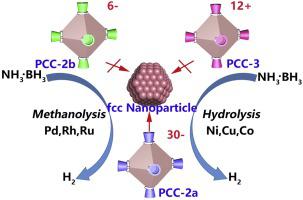Catalysis Today ( IF 5.2 ) Pub Date : 2020-11-24 , DOI: 10.1016/j.cattod.2020.10.030 Yu Fang , Hong-Cai Zhou

|
Metal nanoparticles (M NPs) sometimes suffer from low stability and high aggregation, reducing their reactivity during catalytic cycles. In order to obtain stable and ultrafine noble metal (Ru/Rh/Pd) and first-row transition-metal (Co/Ni/Cu) nanoclusters, several porous coordination cages (PCCs) were applied to confine the nanoparticles within their cavities. Because of the electrostatic attraction, metal cations were only encapsulated by PCC-2a with a highly negatively charged cavity. By in situ reduction, M NPs were synthesized within the cavity of PCC-2a to form stable, ultrafine, and highly active catalyst composite. Through characterization by high resolution transmission electron microscope, the synthesized M NPs were found in face-cubic-centered single crystal form, which were rarely reported. In contrast, cages with only 6- negative charges (PCC-2b) or 12+ positive charges (PCC-3) were unable to obtain high crystalline, ultra-small M NPs, resulting in aggregation and large particle size. Finally, the M NPs@PCC catalysts exhibit different activities in methanolysis and hydrolysis of ammonium borane.
中文翻译:

封装在电荷可调多孔配位笼中的金属纳米粒子用于氢生成反应
金属纳米粒子 (M NPs) 有时稳定性低、聚集度高,从而降低了它们在催化循环中的反应性。为了获得稳定且超细的贵金属 (Ru/Rh/Pd) 和第一排过渡金属 (Co/Ni/Cu) 纳米团簇,应用了几种多孔配位笼 (PCC) 将纳米颗粒限制在其腔内。由于静电引力,金属阳离子仅被 PCC-2a 包裹,带有高度负电荷的腔。通过原位还原,M NPs 在 PCC-2a 的腔内合成,形成稳定、超细、高活性的催化剂复合物。通过高分辨率透射电子显微镜的表征,发现合成的 M NPs 以面立方中心的单晶形式存在,很少报道。相比之下,只有 6- 个负电荷 (PCC-2b) 或 12+ 个正电荷 (PCC-3) 的笼子无法获得高结晶、超小 M NPs,导致聚集和大粒径。最后,M NPs@PCC 催化剂在硼烷的甲醇分解和水解中表现出不同的活性。











































 京公网安备 11010802027423号
京公网安备 11010802027423号